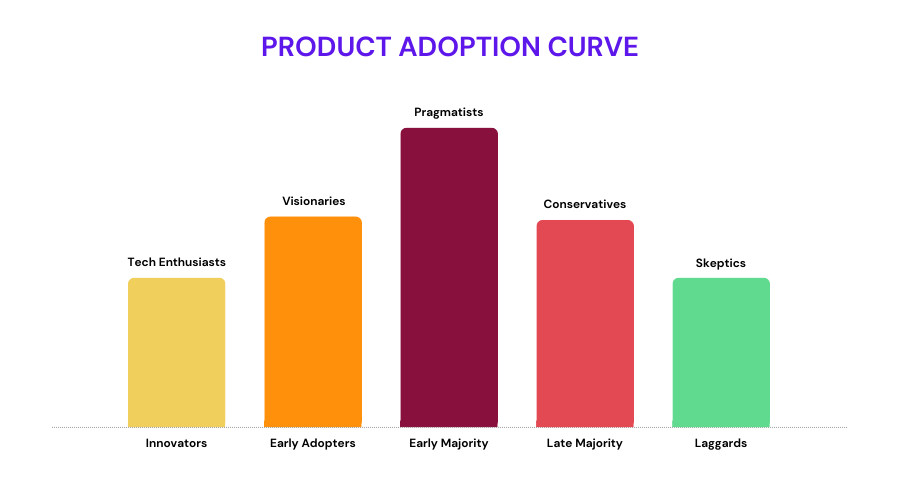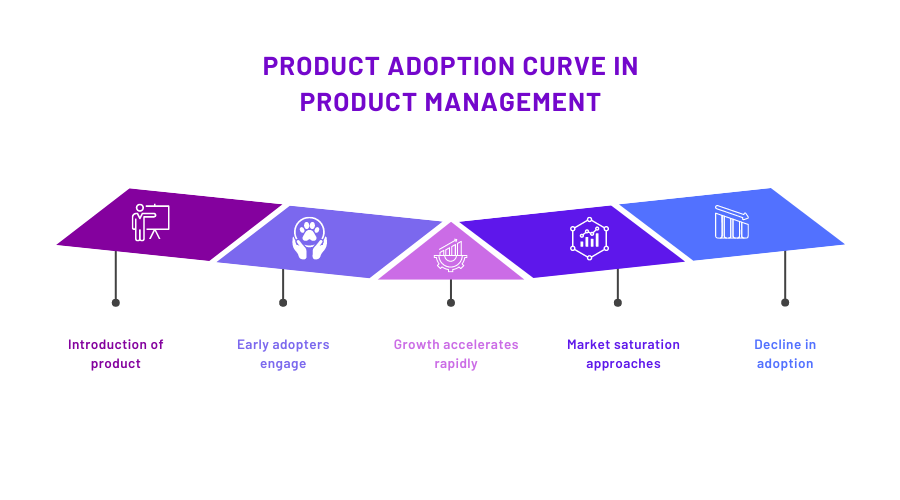Product Adoption Curve: A Guide for Product Managers

Have you ever spent months developing a unique new product only to struggle to get people to use it? You’re not alone. Crafting a quality solution is crucial, but it’s just the first step. How do you get people through the door and into loyal, long-term users?
As a product manager, few things are more frustrating than seeing all your hard work go unused. You know the solution you’ve built has value, but people aren’t seeing it – yet. To ensure your efforts don’t go to waste, you need a plan to steadily grow adoption over time steadily.
This is where understanding the product adoption curve becomes invaluable. Rather than one monolithic group of “users,” different types of people are at various stages of deciding whether your product is right for them. By recognizing who these groups are and catering to their unique needs, you can smooth the journey to widespread use.
In this article, we’ll break down the critical phases of adoption that every new product goes through. Are you ready to take the mystery out of adoption and start putting real strategies in place?
What Is the Product Adoption Curve?
The product adoption curve is a model that helps product teams understand how different types of customers will start using their product over time. Everett Rogers originally developed it in his research on how innovations spread through populations.
The basic idea is that adoption happens in distinct stages as the product gains popularity and acceptance. The model separates customers into groups based on their willingness to try new things.
Early adopters are open to new ideas and willing to take risks. They’ll start using the product right away. Then, the early majority slowly join in once they see early adopters having success.
Next, the late majority feel social pressure to adopt as the product becomes mainstream. Finally, the laggards only start using it once it’s established and proven. Over time, it unfolds as an S-shaped curve as each group gets won over.
Understanding the adoption curve is key. It shows that growth starts slowly as you focus on evangelizing early adopters. Success with them proves the value and gets word-of-mouth spreading.
Focusing support and marketing on each group’s unique needs drives faster adoption rates. The curve predicts when to expect spikes in usage and revenue as more customers get pulled into later stages. With patience and the right tactics for each segment, you can accelerate your company along the curve toward widespread adoption.

Why Is It Important to Understand the Product Adoption Curve?
Understanding the product adoption curve is crucial for companies introducing new technologies and services. It provides valuable insights into how customers react to and integrate the product over time.
Knowing where different types of customers fall on the adoption curve allows companies to optimize their marketing, sales, and customer success strategies for each stage. Early adopters require education and one-on-one support. The early majority needs social proof from references and case studies.
The curve also helps set appropriate expectations for growth. Companies should strategically plan substantial support for innovators and early adopters while addressing bugs and collecting feedback. Growth then picks up as the early majority joins.
It’s ineffective to focus only on wide distribution until the late majority stage. The model shows it’s better to start small with a receptive audience and build momentum.
Leveraging the curve means providing self-service resources for independent users while delivering personalized attention to anchor customers. Their success stories prove the value and pull others through the adoption process faster.
Understanding customer mindsets and when to expect spikes in usage allows companies to scale infrastructure, staffing, and support appropriately over the product lifecycle. It is critical for delivering a seamless experience that drives wider adoption.
Understanding the Product Adoption Curve
The five main categories in the curve are:
- Innovators
- Early Adopters
- Early Majority
- Late Majority
- Laggards
Innovators
Every new product starts its journey with the innovators. The curious early adopters who help blaze a trail for what’s to come. As the first to experience an offering, innovators play a vital role in shaping its future.
While other customer segments seek solutions, innovators are simply seeking the new. They want to be at the forefront of emerging ideas and technologies, testing the waters before broader adoption. This frontier spirit means they’re willing to weather the bumps that come with being pioneers.
Numbering among the smallest audience, innovators nonetheless make an outsized impact. Through their enthusiastic experimentation, feedback, and word-of-mouth, they flag what’s promising and what needs refining. Innovators reporting back helps refine a product into something ripe for broader markets.
Their opinions carry weight in gold for budding businesses. When innovators endorse an offering as innovative and valuable, their initial stamp of approval can spark growing interest from others. Conversely, this discerning group’s critical feedback actively guides a solution away from dead-ends before entirely investing resources.
Innovators present a prime opportunity. Providing these trailblazers with early testing access and a first look at upcoming innovations lets you gain invaluable insights.
At the same time, making them feel privileged to be part of an exclusive beta group fuels their passion for being industry insiders. A wise business nurtures these innovators, helping them feel empowered to shape emerging solutions from the start. Their pioneering spirit just may help light the path to growth.
Chisel’s Idea Box and Product Feedback tools allow innovators to submit new ideas directly and provide feedback on products in development. This gives their voice influence over a product’s direction from the beginning.
Early Adopters
The early adopters are clever trendsetters who see potential where others see problems. Representing around 13.5% of the market, they follow the innovators in recognizing innovation but need more reassurance before fully committing.
Where innovators boldly test unproven ideas, early adopters seek disruption that solves real challenges. They scrutinize products closely and will only adopt if reviews from innovators are positive. Bugs or missing features are dealbreakers for these pragmatic visionaries.
As informal leaders, early adopters’ stamp of approval spreads the word. But they also demand customization and support to maximize value. Give them insight into your development process and address their discerning feedback.
For example, an HR platform signed on forward-thinking recruiters who tested new applicant tracking tools. Addressing their pain points helped optimize the product for wider use. The recruiters then advocated for the software within professional networks, expediting further adoption. The platform built momentum heading into the mainstream market stage by involving early adopter endorsers.
Roadmaps in Chisel provide transparency into the development process. Sharing planned features and timelines with early adopters via Chisel helps build trust and reassurance as the product evolves.
Early Majority Phase
While innovators and early adopters trailblaze new technologies, the early majority wait until solutions have proven themselves. Making up around 34% of consumers, these pragmatists carefully assess options before committing.
Rather than leading trends, the early majority follow. But their adoption is crucial to broader acceptance. They seek multiple validation points to feel confident a purchase is low-risk. Things like friend and expert recommendations, case studies, and robust reviews provide that reassurance.
For example, let us say a marketing automation platform saw slower onboarding from the early majority until showcasing success stories at industry events. Attendees related to clients they recognized, helping visualize the product in real-world scenarios. Sales took off as the carefully curious saw risks mitigated. The platform gained valuable long-term subscribers by addressing information needs specific to this large segment to sustain its growth.
The early majority’s pragmatic nature makes them steady influencers once convinced. Catering content and experiences to their needs for evidence and proof points unlocks widespread reliability testing and word-of-mouth promotion.
Late Majority
While early and mid-phase consumers drive innovation, the late majority of users prove mainstream viability. Comprising another 34% of the population curve, these pragmatic folks adopt when proven benefits outweigh perceived risks.
Cautious by nature, latecomers avoid failures that could harm their business or budgets. But standing still isn’t an option either – competitors using tested solutions could gain an edge.
For example, let us say you are an accounting software company. You knew adoption required addressing both motivators. Client success stories showed seamless transitions and preserved resources. Concurrently, education highlighted features streamlining processes at peer organizations.
These traditionally conservative customers felt empowered to evolve tactically with risk objections overcome and competitive pressures understood. Steady onboarding indicated a tipping point where holdouts accepted validated solutions as the standard.
The late majority’s conservative values shape them as loyal stakeholders once convinced. With two-thirds of the population curve served, a product’s mainstream acceptance is all but guaranteed – its continued refinement now ensures relevance for future generations to come.
Laggards
The laggards represent the final segment of adopters, constituting about 16% of the market. As the name suggests, they exhibit a slow and skeptical approach toward new products or technologies, exemplified by my grandfather, who still prefers writing checks by hand.
These individuals prioritize stability and tradition, are older, and feel less comfortable with digital solutions. They view major changes as risky or unnecessary, holding onto outdated methods even after alternatives become standard unless compelled otherwise.
Although businesses often overlook this group due to their late adoption, catering to laggards can yield additional revenue and market share in the long run, given their significant numbers. The key lies in addressing their specific concerns through education and reassurance. Real-life demonstrations, personal interaction for answering questions, and case studies from trustworthy contacts can boost confidence, along with guarantees to minimize perceived risks.
Failing to adequately address the differences between early adopters and the early majority leads to a roadblock known as “crossing the chasm.”
Early adopters get drawn to the new and unproven, willing to try a product based on its potential. In contrast, the early majority requires proven value before committing, prioritizing stability over risk. Overcoming this challenge necessitates adjusting strategies to resonate with the mindset of the early majority.
While innovators appreciate previewing cutting-edge features, conventional businesses demand robust functionality and support.
Evolving from a passion project to an enterprise-grade solution involves bolstering development teams for scalability and having customer success managers guide implementations. Traditional marketing focuses on practical problems rather than possibilities, transforming risky concepts into established best practices.
Once you establish mainstream trust, the expansion accelerates. Sales shift from persuasion to routine, and upgrades feel secure rather than intimidating. Network effects draw in the late majority, riding coattails of success.
Understanding the ideal customer persona, from visionary to validator, is crucial for achieving product-market fit. Early testing with innovators provides real feedback, but the early majority dictates mass adoption, placing their needs at the forefront post-chasm for a successful crossover.
Suggested Read: Tips To Achieve Product Market Fit
Using the Product Adoption Curve for Product Management
Every new product released goes through an adoption cycle as customers become aware of it, try it out, and decide whether or not to continue using it. Understanding where your customers are in this cycle can provide valuable insights to help guide your product management and development efforts.
The product adoption curve illustrates the typical progression of customers, starting from initial awareness and leading to regular usage. It separates customers into groups representing where they’re at in evaluating and adopting your product. As a product manager, you can use these groups to strategically define your vision and roadmap, prioritize features, and measure adoption over time.
In the early phases, you’ll have innovators and early adopters – your power users who want the latest technologies. Engage with them to gather feedback on usability pain points and feature requests to shape your initial releases. Addressing issues for these groups helps gain momentum as usage spreads.
As awareness grows, the early majority will start considering your product. Still, it may be hesitant without seeing others successfully using it first. To gain their trust, focus on case studies, reviews, and community content. At the same time, continue improving based on early adopter input.
By optimizing the experience for these groups, you help tip the curve to move more customers into the late majority phase, where mainstream adoption occurs. Now that your product has proven itself, the lagging group will also feel comfortable using it.
Throughout this progression, measuring critical metrics like trial conversions, active users, or retention at each stage provides visibility into adoption rates. Any dips could indicate issues to address, while spikes show where optimizations had the most impact. The insights empower data-driven decisions around your feature and content strategy.

For example, you could use customer interviews and adoption metrics to identify that their early and early majority users struggled with the implementation process. It includes guided implementation plans and support resources, improved conversions for those groups, and accelerates the overall adoption of their product across the curve.
Using the Product Adoption Curve for Product Marketing
Let’s dive into some practical ways product marketers can leverage the curve to drive impact.
Developing Targeted Messaging
Customers’ needs and concerns change as they progress through different adoption stages. It’s important to create customized messaging for each stage. In the innovator stage, focus on being at the cutting edge and highlight novel capabilities. For early adopters, demonstrate how the product solves real-world problems.
When targeting the early majority, emphasize ease of use and proven outcomes. The late majority of buyers prioritize well-established brands and risk minimization. Tailor your outreach by segmenting your lists and ensuring the messaging resonates for each adoption stage.
Choosing Effective Communication Channels
Don’t assume a one-size-fits-all approach for channels. Consider where customers typically engage online at each adoption stage. Innovators may prefer niche media and discussion forums. Connect with early adopters at industry events and on LinkedIn.
Leverage webinars, emails, and case studies for the early majority. Television, radio, and print still appeal to late adopters. Test different channel combinations and track their effectiveness at moving customers along their journey.
Measuring Marketing ROI
Marketers often struggle to tie campaigns directly to revenue. Tracking adoption stage provides a solution. Qualify leads and note their stage of progress. Over time, you’ll see what initiatives move which segments further in their journey.
Tweak underperforming campaigns and double down on those demonstrating the highest ROI. Data-driven decisions will maximize your marketing investments.
Building Valuable Influencer Relationships
Early adopters influence others naturally. Invest in cultivating these relationships organically. Provide early access programs and exclusive value to spotlight enthusiastic clients. Nurture a brand advocate community who will spread the word.
Leverage their social authority to spark adoption in subsequent groups. An ongoing influencer strategy pays off as innovative products gain mainstream traction.
Key Takeaways
While understanding and addressing each adoption stage is crucial, the true test is overcoming that pivotal hurdle of the early majority. Once validated by these pragmatic customers, your product earns true mainstream acceptance.
This article helped explain how different types of customers, from innovative risk-takers to cautious late adopters, evaluate new products.
By understanding these personas and their unique concerns, you can craft targeted messaging, choose the right marketing channels, and measure what moves the needle at each stage of the adoption curve.
If you’re struggling to gain momentum or see adoption stall, reviewing your product-market fit using this framework can provide valuable insights. Don’t forget – addressing the needs of those careful early majority customers is critical to taking your product to the next level.
To learn more about how Chisel helps product teams navigate the adoption curve through unified product feedback, roadmapping, and team alignment, visit Chisel. The all-in-one product management platform helps you understand customer and team priorities to refine your product based on real-world data, accelerating adoption across each stage.
